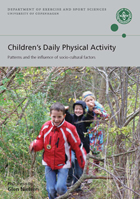PhD defence: Children’s Daily Physical Activity
Patterns and the influence of socio-cultural factors
Glen Nielsen
PhD thesis
The current health discourse and increased rates of inactivity among children have led to numerous initiatives seeking to promote and increase their physical activity levels. Most studies on predictors of Danish children’s physical activity are based on either questionnaire techniques, which only obtain valid measures of the amount of organised physical activity (i.e. sports), or qualitative techniques giving very situation-specific results.
Therefore, little is known about the general patterns and determinants of Danish children’s total range and amount of physical activity. Recognising the importance of both objective measurement and theoretical interpretation, this study combines different methods, data sources, and sociological theories to explore and explain differences in the daily amount of physical activity in a large group of children.
The study investigates how children’s daily physical activity is influenced by gender, ethnicity and social class, as well as social contexts and material facilities. This is done using accelerometer measures of physical activity, school-ground measurements, and questionnaire data about organised sports, family demography, resources and values. Data were collected from more than 500 children from suburban Danish schools when the children were 6 to 7 years old and again later when the children were 9 to 10 years old.
These quantitative data are supplemented with the analysis of qualitative observational data on children’s physical activities in school breaks and sports clubs, in order to inform both the generation of hypothesis and the explanation of associations by illustrative examples. Additional data from 500 children from rural New Zealand schools are used to investigate the influence of school-ground play facilities on physical activity levels, providing a comparison from a different cultural context to Denmark.
Children were observed to have the highest levels of activity in institutional settings for self-organised activity (such as school breaks and after school day care), as well as in organised club- and physical education- settings for physical activity. Children from immigrant families and families of low socio-economic position were not found to be less physically active than other children when their amounts of daily physical activity were measured by direct objective measures, despite their participation rate in organised sports being much lower. This was due to high levels of physical activity in contexts for self-organised play and sports. Multiple logistic regression models revealed that a lack of parental experience with organised sports (family sport capital) and a lack of economic and material resources explained much of the social stratification in sports participation.
Contrasting trends were found when investigating the influence of gender. The two genders were equally active in organised sports, but boys had higher total amounts of physical activity due to higher levels of activity in self-organised settings. This difference could be explained, to some degree, by boys more often playing soccer: an activity that is well catered for in Danish school grounds and afterschool day care institutions. The number of school-ground play facilities that children had access to was positively associated with the daily amount of physical activity and the likelihood of being physically active, independently of differences in gender and socio-economic position.
In conclusion, these results indicate that children’s club organised sports participation is socially stratified with economical and cultural barriers to participation, while children’s everyday institutional settings for self-organised physical activity have gendered barriers to participation in terms of norms and facilities.
The positive correlation between the number of play facilities provided in institutional settings for self-organised play and the children’s overall physical activity level was independent of gender, suggesting the importance of providing numerous and diverse facilities to bridge the observed gender gap in children’s physical activity.
2011, 272 pages, 100,- d.kr.
ISBN: 978 87 917 71 39 2
Time
Monday October 17, 2011 at 14.00 o'clock
Place
Store Auditorium, Nørre Allé 51, DK-2200 Copenhagen N
Opponents
Associate professor Lone Friis Thing (chair), Department of Exercise and Sport Sciences, University of Copenhagen, Denmark
Professor Ken Green, Department of Sport & Exercise Sciences, University of Chester, United Kingdom
Professor Bjørn Holstein, National Institute of Public Health, University of Southern Denmark, Denmark
Supervisors
Professor Gertrud Pfister, Department of Exercise and Sport Sciences, University of Copenhagen.
Professor Lars Bo Andersen, Exercise Epidemiology, Institut for Idræt og Biomekanik, Syddansk Universitet.

